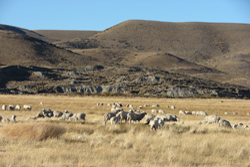Is Made-By’s Environmental Benchmark for Fibres – which compares the environmental impact of the most commonly used fibres in the garment industry – too inflexible to provide an accurate and true comparison between oil and plant-based fibres such as cotton and polyester, and animal fibres such as wool? John Mowbray looks at the evidence.
We approached Made-By after learning of new scientific research which suggests wool could be scoring poorly in rating systems such as Made-By's Environmental Benchmark, as well as the Sustainable Apparel Coalition's Higg Index, due to the misrepresentative, historic LCAs upon which wool's environmental score is currently based. The research proposes new methods for use in LCAs where wool is produced alongside meat or milk, and highlights case studies which suggest this would lead to a much lower environmental impact being allocated to wool.
Put simply, sheep farming produces several products – wool, meat and sometimes milk. At present, many existing LCAs – upon which the likes of Made-By base their environmental scoring for wool – use an ‘economic allocation’ method in terms of ‘allocating’ the environmental impact for these different products. What this means in the instance of co-products from sheep is that wool is ‘allocated’ an environmental burden which is proportionate to the amount of economic revenue it generates relative to the other co-products – meat and milk – from the sheep.
“If the market value of wool rises relative to the co-product (say, lamb) then the environmental burden allocated to wool increases,” Beverley Henry, an associate professor and principal research fellow at the Institute for Future Environments, Queensland University of Technology told Ecotextile News, highlighting one of several anomalies posed by the ‘economic allocation’ method in LCAs.
ISO 14044 provides a hierarchy of recommended methods for allocation in LCAs, with economic being the least preferred. However, as Henry points point, “economic allocation has been most commonly applied in the past because data is readily and conveniently available.”
The new study, funded by the Australian Government and Australian wool growers through Australian Wool Innovation (AWI) and also supported by the International Wool Textile Organisation (IWTO), saw researchers examine seven different methods for handling co-products from case study sheep farms in Australia, New Zealand and the UK.




